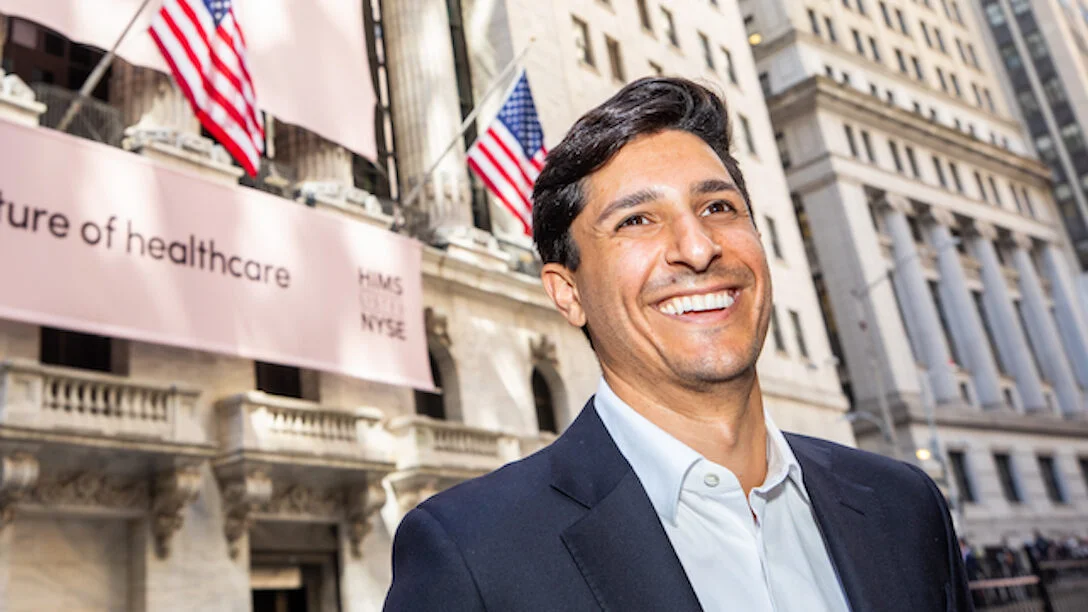
You can listen to our podcast interview with Andrew Dudum here.
In 2017, Andrew Dudum set up a company in the US that he hoped would bring healthcare into the digital age. Hims & Hers is a wellness platform that specialises in treatments for conditions where there is traditionally a stigma attached: hair loss, acne and erectile dysfunction, for example. It allows people access to over-the-counter and prescription drugs, following an online consultation with a qualified doctor.
The company went public on the New York Stock Exchange in 2021, at a valuation of $1.6bn (£1.2bn). It is now valued at more than $3.5bn (£2.7bn). It has more than 1.7 million subscribers, while annual revenues were $870m last year and it turned its first profit in the final quarter of last year (and expects to make a full-year profit this year).
So, what compels someone to take an idea and turn it into a unicorn company? Dudum explains that several formative experiences helped him to develop his business mindset.
First, he grew up in a community of Palestinian-American refugees and immigrants in San Francisco, which was entrepreneurial by nature. Many of his relatives and friends set up their businesses, from laundrettes to liquor stores. They had a “disregard for traditional approaches, [and there was a] forced requirement to have confidence in your decisions,” recalls Dudum. “Creating something from nothing was expected.”
The Wharton School, a business school at the University of Pennsylvania, also had a big impact on him, though in a very different way. The classes were functional, says Dudum, so he studied courses like corporate finance and venture capital fund management. Often, they were taught by entrepreneurs with first-hand experience in business. But he spent a lot of time at the engineering school there too, “trying to persuade software engineers to build things with me” – often bribing them with pizza!
However, perhaps his most formative experiences were at Atomic, a venture fund backed by influential people like Peter Thiel. It followed a hybrid model, both investing in start-up ideas, but also exercising control over the teams that ran them. “It often meant testing 15 to 20 concepts per year,” recalls Dudum, “so we got really good at zero to one.” It allowed him to spot “high-impact ideas” very quickly.
The idea for Hims & Hers was developed at Atomic. And one of the reasons Dudum was able to scale the company so rapidly was because of the lessons he learned there. His team focused on testing customers’ appetite for products and it was flexible about its offering.

They followed the principle “before you build it, prove it”, so they would create “coming soon” landing pages online, for example, to see how much customer interest potential products would generate. Or they made online “waiting lists” to quantify demand. This would tell them if the product offering, like a particular new medical treatment, was worth pursuing.
In the old days, Dudum explains, entrepreneurs would build companies “upside down”: agonise over the brand name, patent it, build a website, choose the colour, then launch to a market where “nobody cares”. Inevitably, it would be the second iteration of the product that would stand a better chance of success.
That whole process might take a year, but his team tries to “compound” that experience into a week, using all the user-testing tricks at the modern digital entrepreneur’s disposal. If you have a high failure tolerance while you scale, and an intelligent approach to failure and feedback, you can brew up success remarkably quickly, he thinks.
California’s high-octane, well-financed, high-risk entrepreneurial culture has inspired Dudum to create a company with huge ambitions for another reason. Dudum could have cashed out his idea earlier but didn’t want to exit with a personal fortune.
“There’s an understanding in The Valley that money brings a very capped amount of happiness,” explains Dudum. “You have a lot of people who have [exited and] made a lot of money and they are deeply unhappy and see you that, you have friends, you have peers.”
To have a true “livelihood” is to be actively running a business, suggests Dudum, because it keeps you “creative and energised”. “As an entrepreneur, I sign up for the journey,” says Dudum, “and the journey is the value.”
You can listen to our podcast episode with Andrew Dudum here:
Related and recommended
Richard Harpin, the founder of HomeServe and Growth Partner and owner of Business Leader, answers your burning business questions
Contestants from The Apprentice reveal the fundamental business lessons they learned from taking part in the TV show
From global talent pools to AI-powered documentation, a work-from-anywhere model is a new way of thinking about productivity, innovation and teamwork
The story of how cycling brought Business Leader member John Readman together with his co-founder and investors




